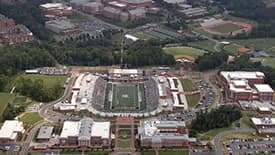Understanding space management – no galaxy required

In the last 15 years, tens of millions of dollars have been spent to increase physical facilities, and it is evident UNC Charlotte will continue to grow “by leaps and bounds.” To date, the 1,000-acre campus has approximately 9.8 million square feet of academic and administrative space in 163 buildings.
With continual enrollment increases, space will continue to be a hot topic – even if when mentioned, someone thinks of outer space.
To become familiar with how the University manages its physical infrastructure, it is important to understand space management.
The Office of Space Management is responsible for how the institution prioritizes and strategically manages University space. “We have to use our existing space more effectively,” explained Kathryn Horne, director of space management.
Concerns for “more space” echo loud and clear, but pressing questions focus more on how well space is used and if current use requires adjustments.
As part of her responsibilities, Horne chairs both the Space Planning Advisory Committee and the Space and Property Steering Committee, which are responsible for reviewing requests for space and making recommendations to the chancellor, who makes all final decisions.
In March, Chancellor Philip L. Dubois and the Cabinet approved the revised University Policy 601.4, Integrated Space Management, which outlines the principles and processes that guide space allocation and use. The policy applies to all space owned, leased or managed by the University.
Since her arrival in 2015, Horne has worked to shift the campus culture by creating awareness of how the University reviews and allocates space needs. “The number one priority is to determine the best use of our space and how usage aligns with institutional goals.”
UNC Charlotte is working in partnership with Gensler, an integrated architecture, design, planning and consulting firm, to complete a space study that will assess the quality and effectiveness of workspace across campus.
In conjunction with the study, a survey is underway and will remain open until April 26. Faculty and staff received an email with a link to the survey earlier this month.
During the next 10 years, space needs will be of paramount significance. Participation in the survey is critical to the University’s plans to assess space utilization for academic and administrative functions on campus.
More information about space management is available online.